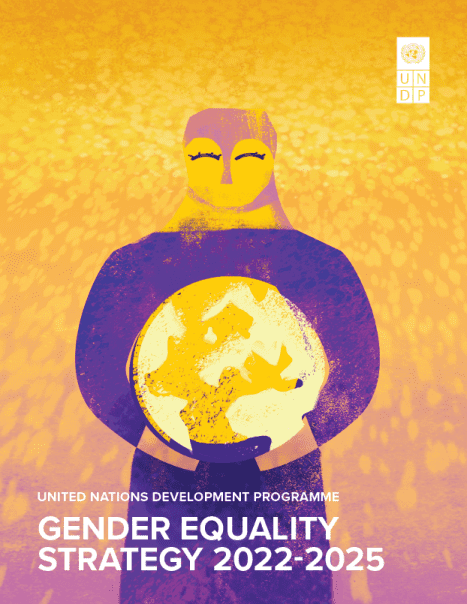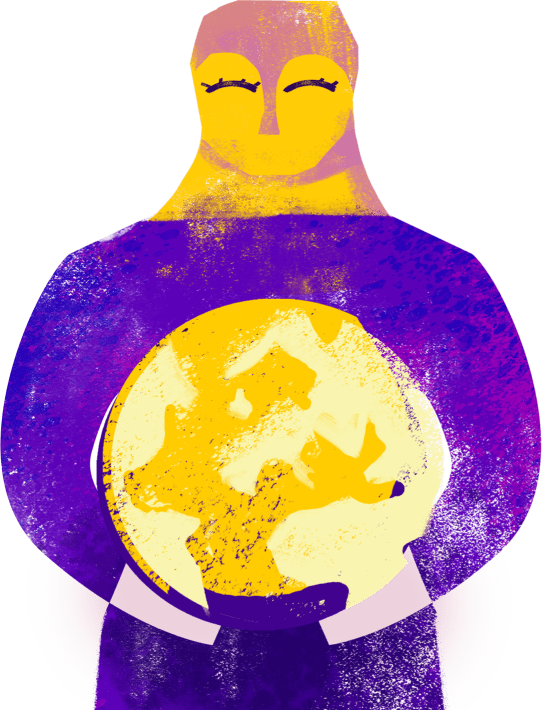Foreword
The United Nations Development Programme’s (UNDP) Gender Equality Strategy 2022-2025 has been created during turbulent times. Multiple crises and risks are threatening the world and we are witnessing an alarming backlash against women’s rights and gender equality. Since the COVID-19 pandemic hit, women have been nearly twice as likely to lose their jobs compared to men. Yet less than 20 percent of policy measures implemented by countries across the world addressed women’s economic insecurity. Gender inequality also takes a toll on men and other affected groups. For men, rigid gender norms can result in risky behaviour resulting in violence, poor health, and lower life expectancy.
At a time when progress towards achieving gender equality is often stalling or even reversing, this ambitious new Gender Equality Strategy will guide UNDP in its efforts to assist countries to move beyond piecemeal efforts towards portfolio approaches that shift power structures and the economic, social, and political systems that perpetuate discrimination.
The strategy is grounded in UNDP’s commitment to eradicating poverty...
Read More
The United Nations Development Programme’s (UNDP) Gender Equality Strategy 2022-2025 has been created during turbulent times. Multiple crises and risks are threatening the world and we are witnessing an alarming backlash against women’s rights and gender equality…
Read MoreAchim Steiner, Administrator, United Nations Development Programme (UNDP)

...reducing inequalities and exclusion, and supporting the empowerment of all women. It describes how UNDP together with our partners, will pursue gender equality -- helping to make a difference to millions of people across the globe through our
six signature solutions, and three ‘enablers’: innovation, digital transformation, and financing for the Sustainable Development Goals (SDGs). That includes ending gender-based violence, tackling the gender dimension of poverty, expanding access to clean, affordable energy, public institutions reform, and helping to unlock additional public and private investment towards gender equality. Crucially, the strategy also asks UNDP to continue advancing gender equality within the organization. Leaders at every level of our organization are encouraged to innovate and seek incremental and breakthrough improvements to unlock the structural changes needed.
Every element of the new strategy draws on knowledge from UNDP’s longstanding engagement to advance gender equality in every corner of the globe. I am deeply grateful to the more than 1,000 colleagues and stakeholders whose contributions helped to produce a strategy that genuinely reflects the diversity and needs of the countries and territories where we operate.
I invite you to read the strategy and learn more. With the support and collaboration of our partners from the UN family -- including our close partnership with UN Women -- and beyond, UNDP will continue to take action with countries and communities to expand people’s choices and realize a just and more equal world.

The Gender Equality Strategy 2022-2025 has been written in unprecedented times. The COVID-19 pandemic has imperilled every dimension of our well-being and amplified a sense of fear across the globe, and there is an alarming escalation in armed violence. This strategy responds to reflections around two key concerns. First, why has progress towards gender equality been so slow and scattered, and even reversed? Second, what can UNDP best do in response?
- Assisting 80 countries to expand care services and redistribute care work.
- Supporting 250 million women to gain access to productive uses of clean energy.
- Helping 1 million more women to access and control digital assets.
- Leveraging and aligning over US$100 billion to contribute to gender equality through taxation systems, public spending, debt instruments and private capital investments.
- Certifying 500 public institutions and private companies with the Gender Equality Seal.
The global context: Crisis and opportunity
The world faces unprecedented planetary and social crises driven by human actions. The COVID-19 pandemic has raised acute questions about why progress continues to lag in many places, for many people, for so long. Development and other thought leaders, including many in feminist movements, have called for rethinking and rebalancing political, economic, social and environmental systems so that they become inclusive and sustainable. UNDP is ready to stand at the vanguard of this call for a new direction, including through this strategy for 2022-2025, recognizing that:

-
The COVID-19 crisis is eroding decades of progress while at the same time opening opportunities for innovative policies on gender equality.
-
Economic inequality is increasing, with a persistent uneven distribution of care.
-
Climate change has become a climate emergency, requiring a green transition that contributes to gender equality and human rights.
-
Governance is at stake, with polarization, democratic regression and serious pushbacks to gender equality.
-
Growing intersecting crises collide with gender norms to determine vulnerability, with war impacts and disaster fatality rates higher for the poorest women.
-
Rapid digitalization has impacts, with potential for widening inequalities but also with enormous power to help close gender gaps in access to and use of technology.
-
A mismatch between commitment and reality persists when it comes to investments, with a tension between collective ambition and financial resources for gender equality.
What we have learned
The Gender Equality Strategy 2022-2025 builds on the progress and lessons of the previous strategy. It draws on insights from assessments and evaluations, and from conversations with government leaders, prominent thinkers, feminist practitioners, civil society, the private sector, the United Nations system and UNDP staff worldwide.
The strategy responds to several key lessons, including that UNDP will:
Help countries to shift power relationships and cut the deep roots of gender inequality.
Be equipped with more sophisticated analysis to address the complexities of gender inequalities.
Integrate gender expertise across teams and invest adequate resources to scale up impact.
Partner with grassroots and women’s organizations to shift policy.
Mobilize financial resources for gender equality and women’s empowerment.
Our partnerships
Over the next four years, UNDP will foster collaborative leadership and learning, valuing diverse sources of knowledge and pursuing creative, emotionally engaging, and analytically sound collaborations. UNDP will pursue new partnerships for gender equality and deepen existing ones to advance longer-term advocacy and policy goals, including with:

UN Women and across the UN system
Civil society, including feminists’ organizations, women’s organizations and other groups advocating for rights
-
New partners who can help shift norms and behaviours to support gender equality, such as faith-based organizations, and networks of young women innovators and influencers
Academia and think tanks
Private sector
Directions of change
UNDP is uniquely capable of taking a whole-of-society approach and helping governments expand national development choices that work for all. During this strategy period and beyond, UNDP will be accompanying countries, driven by national development choices, in pursuing three directions of systemic change that are fundamental to gender equality.

Structural transformation
Working with countries to shift the underlying systems and power structures that determine development, UNDP will ask questions and hold difficult conversations, serving as a convener and advocate as much as, if not more than, a programme provider.
Open inline DIVStructural transformation
Working with countries to shift the underlying systems and power structures that determine development, UNDP will ask questions and hold difficult conversations, serving as a convener and advocate as much as, if not more than, a programme provider.

Leaving no one behind
To ‘reach the furthest behind first’, UNDP will address the multiple and intersecting forms of deprivation, disadvantage, and discrimination such as race, ethnicity, religion or belief, health, status, age, class, caste, and sexual orientation and identity.
Open inline DIVLeaving no one behind
To ‘reach the furthest behind first’, UNDP will address the multiple and intersecting forms of deprivation, disadvantage, and discrimination such as race, ethnicity, religion or belief, health, status, age, class, caste, and sexual orientation and identity.

Building resilience
Helping countries develop capacities to prevent, mitigate and respond to diverse risks and crises, UNDP will put gender equality at the centre of resilience building, including by fully involving women on equal terms and at all levels in decision-making.
Open inline DIVBuilding resilience
Helping countries develop capacities to prevent, mitigate and respond to diverse risks and crises, UNDP will put gender equality at the centre of resilience building, including by fully involving women on equal terms and at all levels in decision-making.

Our priorities
Progress requires sustained action and investment over decades. UNDP will combine shorter-term incremental changes that reach individuals and communities with longer-term reductions in structural barriers that generate changes across social, economic and other systems.
UNDP will pursue gender mainstreaming across each of the five signature solutions of the Strategic Plan reflected in this section, along with stand-alone interventions summarized under signature solution 6.
Priorities represent accelerators where UNDP has demonstrated results and offers comparative advantages. They combine focused attention on closing historical inequities with interventions to achieve women’s empowerment, autonomy, and ability to make choices. With governments in a range of country situations as core partners, UNDP follows a contextualized, country-driven approach to implementing its priorities.

Signature solution 1
POVERTY AND INEQUALITY
Contribute to gender-equal and sustainable economies:
- Universal and gender-responsive social protection and care services
- Fiscal policies that work for gender equality
- Expanded access to essential services, digital and other assets, and finance.

Signature solution 2
GOVERNANCE
Help reinvigorate inclusive governance, participation and women’s leadership :
- Women's collective mobilization, voice and influence
- Towards genderresponsive States
- Achieving gender justice to realize rights.

Signature solution 3
RESILIENCE
Support equal societies to build resilience:
- Fully gender-responsive disaster risk reduction and management
- Resilient economic recovery to advance gender equality
- Women’s leadership and full participation in peace and recovery.

Signature solution 4
ENVIRONMENT
Put gender equality at the heart of caring for people and the planet:
- Gender-responsive management of natural resources
- Implementing gender equality commitments in climate action plans
- Climate finance for gender equality.

Signature solution 5
ENERGY
Close gender gaps in access to modern energy:
- Energy access to unleash women’s economic empowerment
- Energy investments to reduce time poverty
- Galvanizing new knowledge on gender and energy.

Signature solution 6
GENDER EQUALITY
Accelerate the achievement of gender equality and the empowerment of women:
- Inclusive economies and women’s economic empowerment
- Equal power and representation
- Preventing and responding to gender-based violence
- Reversing the backlash against gender equality
- Better data and analysis for policy making
- Changing negative social norms.
Three enablers
Aligned with UNDP’s Strategic Plan, enablers are capacities and approaches to scale up development impact for country partners and within UNDP. To achieve this Gender Equality Strategy, UNDP will pursue three enablers: finance, digitalization and innovation.
Finance
Partnering with governments and the private sector to align public and private finance with gender equality commitments.

Digitalization
Supporting partners to close gender gaps in access to and uses of digital technology.

Innovation
Empowering governments to use a more systemic and transformational lens to address multiple facets of gender inequality at the same time.

Institutional transformation
The Gender Equality Strategy 2022-2025 sets out an ambitious agenda to help countries embrace complexity and find new solutions, responding with flexibility and promoting learning instead of compliance or rigid responses to gender equality. At a pivotal moment for reimagining development, much depends on learning from the past to reframe strategies for our future. The following seven interconnected building blocks will help UNDP scale up impact and achieve transformative results for gender equality. The Gender Equality Seal will continue to be the UNDP global initiative for operationalizing this strategy.
Leaders foster listening and open spaces for self-reflection, pushing beyond comfort zones to change behaviours while modelling power-sharing in practice.
Composed of gender specialists, a gender architecture moves away from mechanical approaches to gender equality and works towards dismantling structural barriers.
New knowledge and innovation transforms how we develop solutions and generates frontier knowledge for gender equality.
UNDP continues to transform as a more inclusive, diverse and harmonious working organization.
Increase investments to achieve our ambition on gender equality and women’s empowerment.
Accountability mechanisms reinforce gender equality – for example, by establishing a Gender Data Powerhouse to provide reliable data on UNDP’s performance.
Communication for advocacy is employed across portfolios, including accessible messages to foster strategic dialogues with stakeholders.

